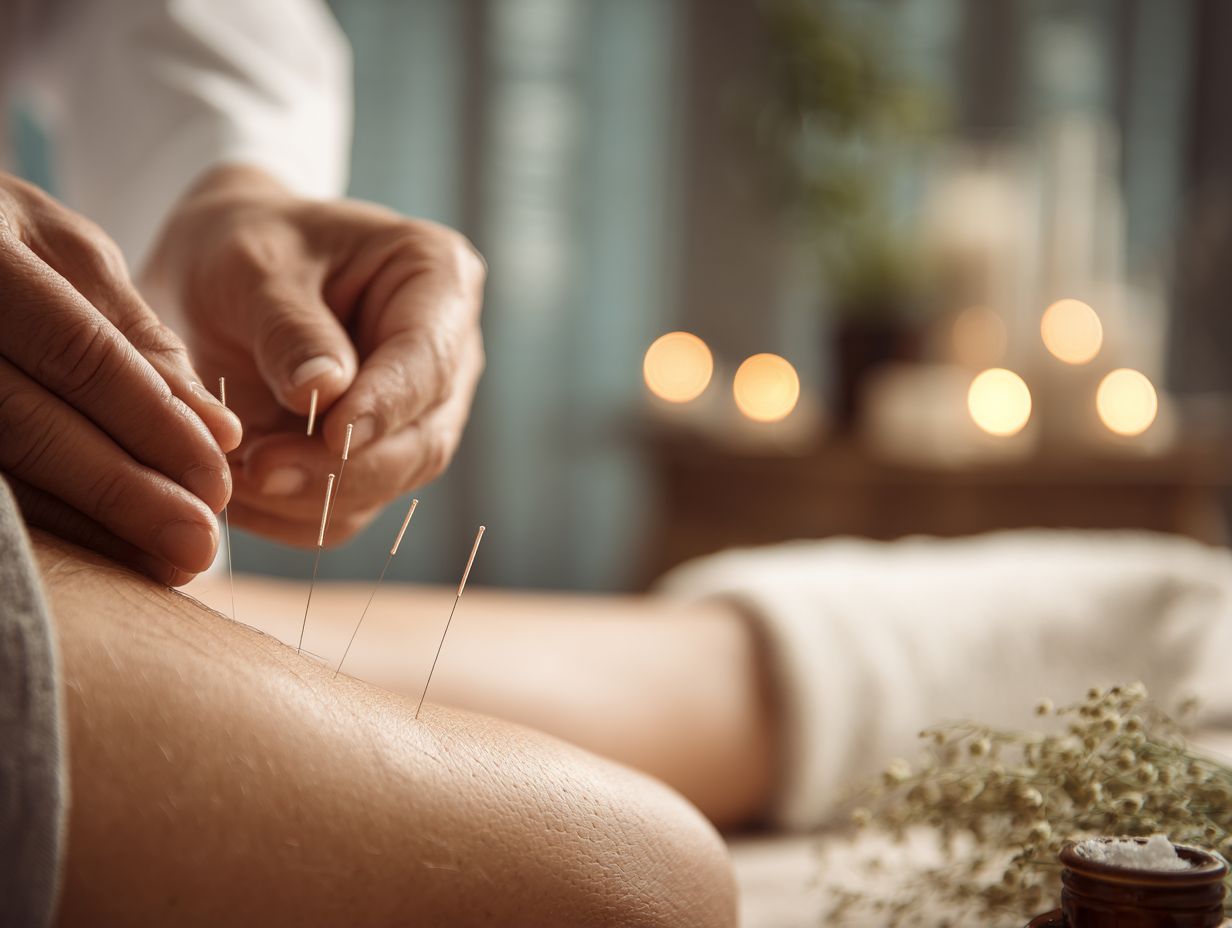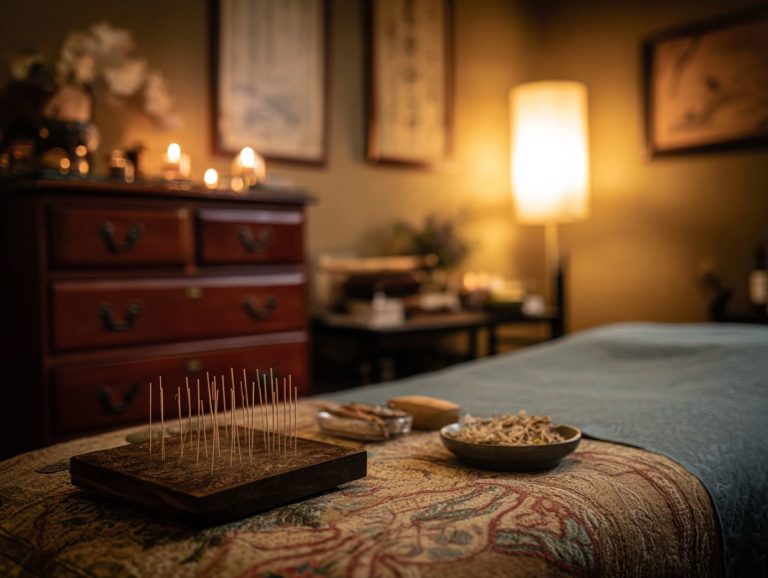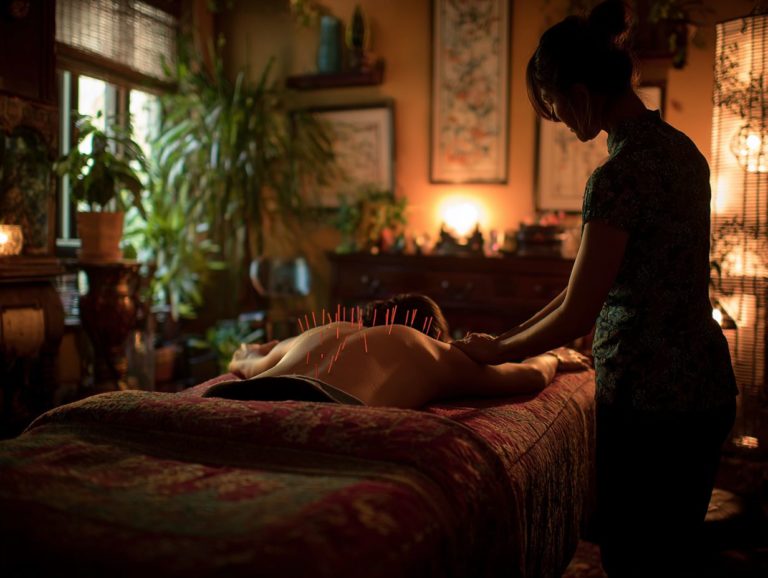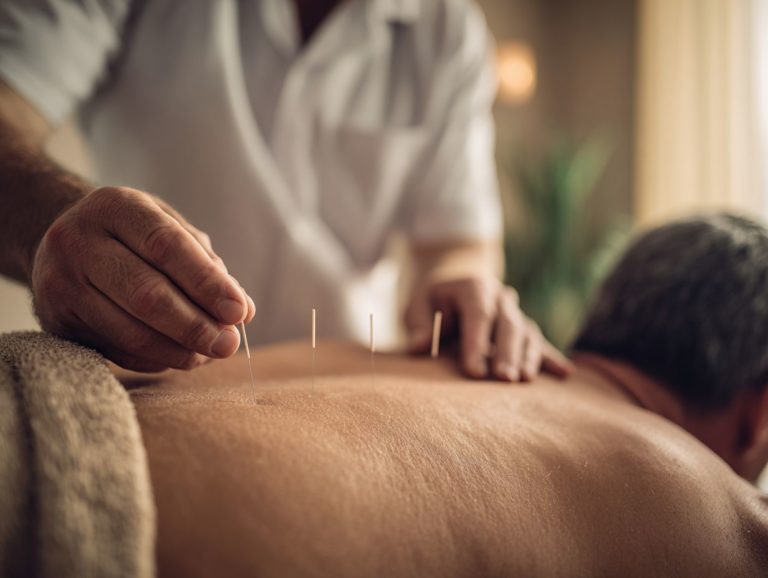Acupuncture for Osteoarthritis: Techniques and Benefits
Struggling with knee pain from osteoarthritis? Acupuncture offers a promising nonpharmacologic therapy that could help alleviate your discomfort. This old method helps reduce pain and improves joint movement, offering a complete way to handle osteoarthritis. In this article, we will look at different acupuncture methods and their benefits, helping you choose the right treatment for your osteoarthritis. Learn how acupuncture can help you improve your health.
Key Takeaways:
Contents
- 1 Understanding Acupuncture
- 2 Mechanisms of Acupuncture in Pain Relief
- 3 Techniques of Acupuncture for Osteoarthritis
- 4 Benefits of Acupuncture for Osteoarthritis
- 5 Research and Evidence
- 6 Efficacy of Acupuncture in Osteoarthritis Management
- 7 Potential Risks and Considerations
- 8 Integrating Acupuncture into Osteoarthritis Management
- 9 Frequently Asked Questions
- 9.1 What is acupuncture and how does it help with osteoarthritis?
- 9.2 What are the different techniques used in acupuncture for osteoarthritis?
- 9.3 Is acupuncture safe for treating osteoarthritis?
- 9.4 How many acupuncture sessions are needed for osteoarthritis treatment?
- 9.5 What are the potential benefits of acupuncture for osteoarthritis?
- 9.6 Does insurance cover acupuncture for osteoarthritis treatment?
Definition and Overview

Osteoarthritis is defined as the breakdown of cartilage in joints, resulting in pain, stiffness, and decreased mobility.
This degenerative joint disease occurs when the smooth tissue cushioning the ends of bones gradually wears away, leading to bones rubbing against each other. As a result, the body may respond with inflammation, producing excess joint fluid and bone spurs, exacerbating discomfort.
To manage osteoarthritis effectively, consider doing gentle exercises like swimming or biking, using non-prescription pain relievers such as ibuprofen, and maintaining a healthy weight to reduce stress on the joints.
Seeing a physical therapist can give you exercise plans made just for you to help you move better and feel less pain.
Prevalence and Impact
According to the Nationwide Health and Nutrition Examination Survey, over 32 million adults in the U.S. are affected by osteoarthritis, highlighting its widespread prevalence.
This condition predominantly affects older adults, with a marked increase in cases among those over 65.
Economically, the burden on healthcare systems is substantial; osteoarthritis contributes to approximately $140 billion annually in treatment costs and lost productivity. As noted in research by ScienceDirect, understanding the economic impact on a global scale is essential for devising effective healthcare policies.
Beyond financial impacts, osteoarthritis significantly diminishes quality of life, leading to chronic pain and reduced mobility. Studies show that patients often report difficulties in performing daily activities, negatively affecting mental health.
For effective management, integrating physical therapy and lifestyle modifications is essential for improving patient outcomes.
Understanding Acupuncture
Acupuncture, which comes from old Chinese medicine, is being noticed as a drug-free treatment to help with osteoarthritis pain. For those interested in how acupuncture alleviates pain, consider reading about the mechanisms, methods, and insights of acupuncture for pain relief.
History and Origins
Acupuncture dates back over 2,500 years to ancient China, where it was developed as a method for balancing bodily energies and alleviating pain.
Acupuncture, which comes from Traditional Chinese Medicine, is based on the idea that life energy, known as qi, moves through pathways in the body. Experts think that interruptions in this process can lead to health problems.
At first, it was used to manage pain, but then its use expanded to different cultures such as Japan and countries in the West, where studies started to confirm that it works.
Acupuncture is used worldwide today, with techniques adjusting to local medical practices and beliefs, which has greatly increased its acceptance in regular healthcare.
Principles of Acupuncture
The practice of acupuncture is based on the principles of Qi (energy flow), meridians, and the balance of Yin and Yang.
Practitioners begin by assessing a patient’s overall energy balance, often through observation, questioning, and pulse examination. They identify areas of stagnation or deficiency in Qi, which may manifest as symptoms like pain or fatigue.
Once these imbalances are determined, practitioners select specific acupuncture points along the meridians to stimulate. For example, a practitioner might target the Large Intestine 4 (Hegu) point to alleviate headaches, while the Spleen 6 (Sanyinjiao) is often chosen for digestive issues.
Each treatment is customized to personal needs, encouraging complete healing. For an extensive analysis of the benefits and various methods used in acupuncture, our comprehensive guide on acupuncture explores its applications in pain relief.
Mechanisms of Acupuncture in Pain Relief
Studies show that acupuncture can influence the way pain signals are processed through different brain and nerve functions, which may help people with osteoarthritis feel less pain.
Neurobiological Effects
Acupuncture affects neurobiological processes by stimulating specific areas of the brain associated with pain modulation, leading to reduced pain perception.
Research indicates that acupuncture can stimulate areas in the brain such as the anterior cingulate cortex and prefrontal cortex, which are important for managing emotions and dealing with pain.
For example, a 2018 study in the Journal of Pain found that patients receiving acupuncture reported a significant decrease in pain levels compared to those who did not.
Measuring changes in brain activity through fMRI scans showed that acupuncture can reduce pain and improve overall well-being by adjusting stress responses and improving mood control. This understanding is supported by findings from Frontiers in Neuroscience on the neurobiological mechanisms of acupuncture.
Release of Endorphins
One significant mechanism of acupuncture’s effectiveness lies in its ability to stimulate endorphin release, which helps in naturally reducing pain levels.
Scientific studies have shown that acupuncture can significantly increase endorphin levels in the body.
For example, a study from 2012 in the Journal of Pain showed that people getting acupuncture said their pain went down, and their blood had higher endorphin levels.
Patients often experience a rush of well-being post-treatment, reminiscent of a runner’s high.
Adding acupuncture to a pain management plan can work well with other treatments and offer a well-rounded method for relief, improving overall well-being.
Techniques of Acupuncture for Osteoarthritis

Different acupuncture methods, both traditional Chinese and contemporary ones, provide customized treatments for osteoarthritis.
Traditional Chinese Medicine Approach
The Traditional Chinese Medicine (TCM) method focuses on whole-body diagnosis, using acupuncture points that match particular osteoarthritis symptoms.
Key acupuncture points often include Kneecap Hole (Xuehai), located just below the knee, to alleviate pain and inflammation. Another important point is Spleen 9 (Yinlingquan), which helps manage body fluids and decreases swelling.
TCM asserts that targeting these points balances energy flow, aiding joint health. Treatment plans typically consist of 8-12 sessions, with adjustments based on individual symptoms and overall progress.
This specific approach deals with the physical symptoms as well as the deeper issues that lead to osteoarthritis pain.
Electroacupuncture
Electroacupuncture, which involves the application of electrical stimulation to acupuncture needles, has shown promising results in enhancing pain relief for osteoarthritis patients.
Many clinical studies confirm it works well. For example, a randomized controlled trial published in the Journal of Pain Research found that participants receiving electroacupuncture reported a significant reduction in pain compared to those receiving standard treatment.
The method is particularly beneficial as it can target specific muscle groups, leading to improved mobility. Patients usually have sessions that last 20-30 minutes. They can happen weekly or every other week, depending on how severe the condition is.
As with any treatment, you should talk to a healthcare professional to find the best approach for your needs. For an in-depth look at the clinical efficacy of electroacupuncture in chronic pain treatment, the Journal of Pain Research provides valuable insights in their thorough analysis.
Acupressure Techniques
Acupressure, a non-invasive alternative to acupuncture, applies pressure to specific points on the body, offering pain relief and function improvement for osteoarthritis patients.
To apply acupressure effectively, focus on key points such as the K-27 point, located at the base of your collarbone, which can help alleviate shoulder and upper back pain.
Another important point is the LI-4, found between the first and second metacarpal bones on the hand. Press your thumb firmly on these spots for 1-2 minutes multiple times a day.
Acupressure mats can help treatment by giving extra stimulation, and deep breathing during this can increase relaxation and reduce pain.
Benefits of Acupuncture for Osteoarthritis
Acupuncture offers many benefits for people with osteoarthritis, including less pain and better joint movement. For a deeper understanding of its methods and applications, you might consider exploring how it can be used for pain relief, as detailed in our comprehensive guide on acupuncture benefits and techniques.
Pain Reduction
Studies have demonstrated that acupuncture can significantly reduce pain levels in osteoarthritis patients, providing measurable relief.
In a review of 29 trials involving over 3,500 participants, acupuncture was found to decrease pain scores by an average of 20% compared to control groups.
Notably, a 2016 meta-analysis indicated that patients receiving acupuncture experienced more significant pain reduction than those who received standard care alone.
Acupuncture worked better when used together with physical therapy, showing how combining treatments can be beneficial.
Patients should consult with qualified practitioners to tailor sessions based on individual needs and pain levels for optimal results.
Improved Joint Function
Patients receiving acupuncture have reported improved joint function, facilitating better mobility and daily activities.
Research shows that acupuncture can greatly improve movement, especially for conditions such as osteoarthritis.
One study found that after 12 sessions, participants experienced a 30% improvement in joint movement and a noted increase in physical activity levels.
Practitioners often focus on certain acupoints, like LI4 (Hegu) to help with general pain relief and ST36 (Zusanli) to increase energy and support recovery.
Adding acupuncture to a treatment plan can greatly improve joint health and mobility, helping patients to be more active in their daily lives.
Enhanced Quality of Life
Clinical studies show that regular acupuncture treatments significantly improve the quality of life for people with osteoarthritis.
Beyond pain relief, acupuncture positively affects sleep quality, mood, and daily functioning. Research indicates that patients often report reduced anxiety levels and improved emotional well-being after sessions.
For example, a study in the journal Pain found that 70% of participants felt better and more energetic.
To maximize these benefits, patients are encouraged to engage in regular treatments, ideally weekly, and consider complementary practices such as physical therapy or mindfulness exercises. This method helps improve the overall quality of life for people with osteoarthritis.
Research and Evidence

Research increasingly shows that acupuncture can help manage osteoarthritis. This includes findings from clinical trials and detailed reviews.
Efficacy of Acupuncture in Osteoarthritis Management
Beyond osteoarthritis, acupuncture has been studied for its broader pain relief mechanisms. For instance, it’s important to understand how acupuncture methods work to manage different types of pain effectively (our insights on pain management mechanisms provide a deeper exploration).
Efficacy of Acupuncture in Osteoarthritis Management
Acupuncture in Osteoarthritis: Effectiveness Measures
Acupuncture in Osteoarthritis: Comparator
Acupuncture in Osteoarthritis: Demographics and Settings
The Efficacy of Acupuncture in Osteoarthritis Management examines the impact of acupuncture on patients suffering from osteoarthritis, focusing on pain reduction, functional mobility, and quality of life improvements. This data sheds light on the potential benefits of acupuncture as a complementary therapy for a condition characterized by joint pain and stiffness.
Acupuncture in Osteoarthritis reveals quantitative measures of acupuncture’s effectiveness. The data indicates a pain intensity reduction (VAS) of -0.29, suggesting a moderate decrease in pain levels among patients. Further, acupuncture contributes to a functional mobility improvement (SMD) of -0.34 This means improved movement and less joint stiffness. Notably, acupuncture also promotes a quality of life improvement (SMD) of -0.36, reflecting better overall well-being and daily functioning for individuals undergoing treatment.
- Comparator: Observations over interventions lasting more than 4 weeks show a mean difference (MD) of -0.38, indicating sustained effectiveness of acupuncture over extended periods. In trials with a low risk of bias, pain intensity reduction reaches -0.59, highlighting stronger results when study integrity is high.
- Demographics and Settings: The trials mainly done in Europe contribute to 75% of studies, showing regional interest and acceptance. The demographic data reveals that 65% of participants were female This suggests that osteoarthritis might be more common in women or that women are more likely to try acupuncture therapy.
In summary, acupuncture demonstrates measurable benefits in managing osteoarthritis symptoms, with notable improvements in pain, mobility, and life quality. The emphasis on long-term treatments and trial accuracy highlights the potential for acupuncture as a helpful addition in medical treatments, particularly in Europe where most trials take place.
Clinical Trials and Studies
Many clinical studies have shown that acupuncture can greatly reduce pain and improve function in people with osteoarthritis.
For example, a prominent study involving 500 participants showed a marked reduction in pain scores after eight weeks of acupuncture treatment, with many reporting sustained relief for up to six months.
Another trial with 100 patients found that combining acupuncture with standard therapies improved overall function and quality of life.
Researchers use standardized pain assessment scales to provide consistent and trustworthy data. These trials highlight acupuncture not just as a complementary therapy, but as a viable approach to enhancing osteoarthritis management alongside traditional methods.
Meta-analyses and Systematic Reviews
Research combining various studies shows that acupuncture helps reduce symptoms of osteoarthritis.
For instance, a meta-analysis encompassing over 20 randomized controlled trials revealed that acupuncture significantly reduced pain and improved functional mobility in adults with osteoarthritis, particularly in the knee.
The studies often used needles on specific spots like LI4 (Hegu) and ST36 (Zusanli), which are traditionally thought to improve joint health. Patients typically experienced lasting benefits beyond immediate treatment, with many reporting improved quality of life after just a few sessions, reinforcing acupuncture’s role as a viable complementary therapy.
Potential Risks and Considerations
Though acupuncture is usually safe, there are possible risks and things patients should know before beginning treatment.
Side Effects of Acupuncture

Common side effects of acupuncture include mild pain at injection sites, temporary fatigue, and, in rare cases, infections if not performed correctly.
To reduce risks, practitioners should stick to well-established procedures.
- First, always use sterile, single-use needles to prevent infections.
- Make sure the acupuncture area is clean and free of germs by using antiseptic wipes.
- Practitioners should maintain open communication with clients about their health history, as certain conditions may increase the risk of complications.
- Watching patients for unusual symptoms after treatment can help quickly spot any negative reactions.
- Regular training and certification in acupuncture techniques are essential for keeping safety standards high.
Who Should Avoid Acupuncture?
Certain populations, such as individuals with bleeding disorders or those who are pregnant, should avoid acupuncture unless cleared by a healthcare provider.
Individuals with certain skin conditions like eczema or psoriasis should also exercise caution, as acupuncture might aggravate these issues.
To address these concerns, healthcare providers can offer alternative treatments such as physical therapy or acupressure, which may have fewer risks. Teaching patients about these options helps them make well-informed decisions.
Doctors need to look at a patient’s medical history and discuss potential risks, giving care suited to their health needs.
Integrating Acupuncture into Osteoarthritis Management
Including acupuncture in a complete osteoarthritis care plan can improve results when used with standard treatments.
Complementary Therapies
Acupuncture can be helpful when used with treatments like physical therapy and exercise programs, offering a thorough approach to managing osteoarthritis.
Combining acupuncture with a customized physical therapy program can help increase mobility and reduce discomfort. A study showed that patients who underwent weekly acupuncture sessions alongside physical therapy reported a 30% improvement in function compared to those receiving physical therapy alone.
Adding gentle exercise, like yoga or swimming, can improve results by increasing joint flexibility and reducing stiffness. This combined method deals with symptoms and helps patients by encouraging lifestyle changes that support lasting health.
Frequently Asked Questions
What is acupuncture and how does it help with osteoarthritis?
Acupuncture is a traditional Chinese medicine technique that involves inserting thin needles into specific points in the body to stimulate energy flow. This helps to relieve pain and inflammation associated with osteoarthritis by promoting the release of natural pain-relieving chemicals in the body.
What are the different techniques used in acupuncture for osteoarthritis?
The most common techniques used in acupuncture for osteoarthritis include traditional Chinese acupuncture, electroacupuncture, and trigger point acupuncture. Each technique has its own unique approach to treating osteoarthritis and may be used in combination for optimal results.
Is acupuncture safe for treating osteoarthritis?
Yes, acupuncture is generally considered a safe and effective treatment for osteoarthritis. The needles are extremely thin and placed just below the surface, so the procedure is almost pain-free. However, you should get treatment from a certified and experienced acupuncturist to make sure it is safe and works well.
How many acupuncture sessions are needed for osteoarthritis treatment?
The number of acupuncture sessions needed for osteoarthritis treatment varies for each individual. Some may see improvement after just a few sessions, while others may require ongoing treatment. The effectiveness of acupuncture varies based on how serious the condition is and how the person responds to the treatment.
What are the potential benefits of acupuncture for osteoarthritis?
Acupuncture can provide various benefits for those suffering from osteoarthritis, including pain relief, reduced inflammation, improved joint mobility and function, and increased overall well-being. It can be combined with other treatments for a stronger method to handle osteoarthritis.
Does insurance cover acupuncture for osteoarthritis treatment?
Some insurance plans may cover acupuncture for osteoarthritis treatment, although coverage may vary. It is best to check with your insurance provider to see if acupuncture is covered and what the specific requirements may be. Many acupuncturists provide payment plans or flexible fees for people who do not have insurance.

Sheetal Sharda has a background in CS. She got an interest in Holistic living back in 2018, and has since started exploring more into Naturapathy, Holistic Living, Yoga, and more. She got inspired to start SereneClinics to help people find reliable centers across the world.





